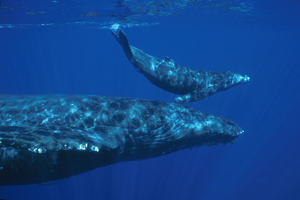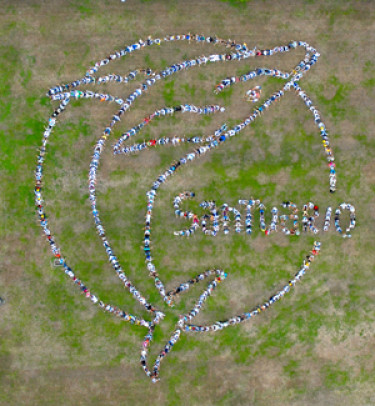
A humpback whale and its calf in NOAA's Hawaiian Islands Humpback Whale National Marine Sanctuary.
Download here. (Credit: NOAA)
NOAA, with staff from the State Department, U.S. Marine Mammal Commission, Department of the Interior and private citizens representing the U.S. at the International Whaling Commission (IWC), arrived in Panama for this year's 64th meeting armed with years of experience and an unrelenting commitment to conserve our planet's whales.
Eighty-nine countries, including the U.S., make up the Commission. The countries split between those that support commercial whaling and countries opposed to commercial whaling.
The IWC's mission is to conserve large whale populations by promoting the recovery of depleted stocks, while maintaining populations considered healthy. The IWC also holds responsibility for establishing a system of international regulation for commercial and subsistence whale hunts.
"It's incredibly challenging at times to come to agreement, but it's a process that N.O.A.A. and our partners are totally dedicated to," said Doug DeMaster, the U.S. commissioner to the IWC. "I've been doing this for 23 years, and we've seen everything from countries walking out of difficult discussions to consensus being reached within a single session."

Nongovernmental organizations attending the IWC in Panama organized this human formation to show their support for whales. In excess of 500 IWC attendees and local Panamanians participated.
(Credit: Courtesy of The Whaleman Foundation.)
Although the IWC has maintained a moratorium on commercial whaling for almost 30 years, which the U.S. supports, Japan, Iceland and Norway continue to whale using legal means that circumvent the spirit and intent of the moratorium. Tensions often peak during discussions at the IWC on this issue and others.
This year, the Panama meeting brings fresh challenges that could either help modernize the Commission or put deeper cracks in an organization that tends to be vehemently divided. To pass amendments to the Convention's schedule of regulations, 3 quarters of dues-paying members attending the meeting must agree.
One of the biggest issues driving the discussions this year is subsistence hunting for indigenous communities, including the U.S.'s Alaska Natives and the Makah Tribe.
Negotiations between the U.S. delegation and other delegations are key to IWC meetings. The U.S. team represents the American people and the whales that migrate between countries all over our planet.
"Many whale populations have been hunted to near extinction, and some have not yet recovered from industrial whaling," said Ryan Wulff, U.S. alternate commissioner. "In addition, whales face many other threats today including ship strikes, chemical and noise pollution, entanglement in fishing gear, oil spills and climate change. Our job is to help protect them, and yet to provide for sustainable hunts that meet the needs of our subsistence communities."
NOAA's team faces herculean challenges at this year's meeting. They understand the science and politics involved, they know most of the players, and they are moving forward with complete resolve to continue protecting our planet's whales.
Learn more: Follow us on Twitter at @USAforWhales, and visit our webpage at http://www.noaa.gov/iwc/index.php.
NOAA's mission is to understand and predict changes in the Earth's environment, from the depths of the ocean to the surface of the sun, and to conserve and manage our coastal and marine resources. Join us on Facebook, Twitter and our other social media channels.

